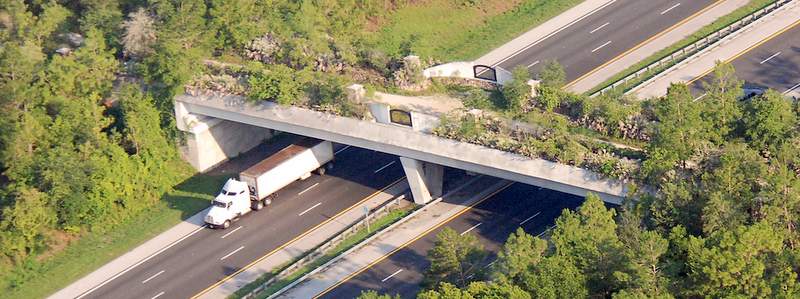

It’s always heartbreaking when I hear that yet another Florida black bear or Florida panther has gotten killed on a Florida road.
So far this year, vehicle collisions killed an average of two endangered Florida panthers a month. And for bears, the toll is worse: About 20 black bears die every month on roadways as they travel the state looking for food and mates. And we all see many other dead creatures — deer, squirrels, opossums, bobcats, birds, reptiles and more — along our roadsides. This hurts people too: An estimated 200 people are killed and 29,000 injured yearly in the U.S. when their cars collide with animals.
The good news is that we can prevent this, and we have proven technology to do it. Building safe crossings for wildlife can reduce the carnage to nearly zero. Wildlife crossings take a number of different forms — expanded culverts, special ledges built along rivers or canal banks under highway bridges, or full-blown landscaped overpasses, like the striking forested Cross Florida Greenway Land Bridge over Interstate 75 near Ocala.
In Tallahassee, a study showed that 90 percent of the turtles that tried to cross Highway 27 from Lake Jackson to a nearby waterway didn’t make it. Since the Lake Jackson Ecopassage was built under the roadway in 2010, the death toll has dropped to zero because turtles, alligators, and other creatures are now funneled by fencing to a culvert that allows them to pass between water bodies without dodging traffic.
More good news: A project that the Florida Wildlife Federation sparked years ago is finally a reality. It’s along a nine-mile stretch of Alligator Alley (which runs from Naples to Fort Lauderdale) that was a renowned hot spot for dangerous collisions, especially Florida panther deaths. The Florida Wildlife Federation commissioned a detailed study of the problem in 2015, sent a letter to the state petitioning action, and today there is finally a system of fencing and underpasses to help wildlife cross safely. In Southwest Florida, we’ve been involved in 50 different wildlife crossings so far, and we are excited to be involved with even more projects statewide.
Think about how nerve-wracking it is for us to try to dodge traffic when we have to run across a highway – just imagine how confusing it is for a wild animal to be moving through the woods and suddenly confronted by a road with speeding cars everywhere.
The highway crossings we’re installing have another important benefit besides cutting collisions: They provide key connections so that animals can roam in search of mates, which helps prevent inbreeding and protects a healthy gene pool for whole populations.
Since wildlife watching contributes $5.8 billion yearly to Florida’s economy, it makes sense for us to do what we can to keep our wildlife populations healthy and protected. If we humans are going to take over their landscape, the least we can do is use whatever tools we can to make it safer for them so we can all coexist.
___
Manley Fuller is president of the Florida Wildlife Federation.



